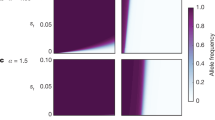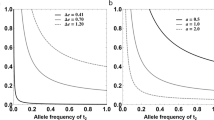Abstract
Females of the arctiid moth Utetheisa ornatrix mate preferentially with larger males, receiving both direct phenotypic and indirect genetic benefits1. Here we demonstrate that the female's mating preference is inherited through the father rather than the mother, indicating that the preference gene or genes lie mostly or exclusively on the Z sex chromosome, which is strictly paternally inherited by daughters. Furthermore, we show that the preferred male trait and the female preference for that trait are correlated, as females with larger fathers have a stronger preference for larger males. These findings are predicted by the protected invasion theory2,3, which asserts that male homogametic sex chromosome systems (ZZ/ZW) found in lepidopterans and birds promote the evolution of exaggerated male traits through sexual selection. Specifically, the theory predicts that, because female preference alleles arising on the Z chromosome are transmitted to all sons that have the father's attractive trait rather than to only a fraction of the sons, such alleles will experience stronger positive selection and be less vulnerable to chance loss than would autosomal alleles.
This is a preview of subscription content, access via your institution
Access options
Subscribe to this journal
Receive 51 print issues and online access
$199.00 per year
only $3.90 per issue
Buy this article
- Purchase on Springer Link
- Instant access to full article PDF
Prices may be subject to local taxes which are calculated during checkout



Similar content being viewed by others
References
Iyengar, V. K. & Eisner, T. Female choice increases offspring fitness in an arctiid moth (Utetheisa ornatrix). Proc. Natl Acad. Sci. USA 96, 15013–15016 (1999)
Reeve, H. K. Haplodiploidy, eusociality and absence of male parental and alloparental care in Hymenoptera: a unifying genetic hypothesis distinct from kin selection theory. Phil. Trans. R. Soc. Lond. B 342, 335–352 (1993)
Reeve, H. K. & Shellman-Reeve, J. S. The general protected invasion theory: Sex biases in parental and alloparental care. Evol. Ecol. 11, 357–370 (1997)
Conner, W. E., Roach, B., Benedict, E., Meinwald, J. & Eisner, T. Courtship pheromone production and body size as correlates of larval diet in males of the arctiid moth, Utetheisa ornatrix. J. Chem. Ecol. 16, 543–552 (1990)
Dussourd, D. E., Harvis, C., Resch, J., Meinwald, J. & Eisner, T. Pheromonal advertisement of a nuptial gift by a male moth (Utetheisa ornatrix). Proc. Natl Acad. Sci. USA 88, 9224–9227 (1991)
LaMunyon, C. W. & Eisner, T. Spermatophore size as determinant of paternity in an arctiid moth (Utetheisa ornatrix). Proc. Natl Acad. Sci. USA 91, 7081–7084 (1994)
LaMunyon, C. W. Increased fecundity, as a function of multiple mating, in an arctiid moth, Utetheisa ornatrix. Ecol. Entomol. 22, 69–73 (1997)
González, A., Rossini, C., Eisner, M. & Eisner, T. Sexually transmitted chemical defense in a moth (Utetheisa ornatrix). Proc. Natl Acad. Sci. USA 96, 5570–5574 (1999)
Iyengar, V. K. & Eisner, T. Heritability of body mass, a sexually selected trait, in an arctiid moth (Utetheisa ornatrix). Proc. Natl Acad. Sci. USA 96, 9169–9171 (1999)
Opler, P. A. & Krizek, G. O. Butterflies East of the Great Plains (John Hopkins Univ., Baltimore, 1984)
LaMunyon, C. W. & Eisner, T. Postcopulatory sexual selection in an arctiid moth (Utetheisa ornatrix). Proc. Natl Acad. Sci. USA 90, 4689–4692 (1993)
Lande, R. Models of speciation by sexual selection on polygenic traits. Proc. Natl Acad. Sci. USA 78, 3721–3725 (1981)
Andersson, M. Sexual Selection (Princeton Univ. Press, Princeton, 1994)
Lynch, M. & Walsh, B. Genetics and Analysis of Quantitative Traits, 4th edn (Sinauer, Sunderland, 1998)
Houde, A. E. Sex-linked heritability of a sexually selected character in a natural population of Poecilia reticulata (Pisces: Poeciliidae) (guppies). Heredity 69, 229–235 (1992)
Wilkinson, G. S., Kahler, H. & Baker, R. H. Evolution of female mating preferences in stalk-eyed flies. Behav. Ecol. 9, 525–533 (1998)
Brooks, R. & Endler, J. A. Female guppies agree to differ: phenotypic and genetic variation in mate-choice behaviour and the consequences for sexual selection. Evolution 55, 1644–1655 (2001)
Brooks, R. & Endler, J. A. Direct and indirect sexual selection and quantitative genetics of male traits in guppies (Poecilia reticulata). Evolution 55, 1002–1015 (2001)
Wolfenbarger, L. L. & Wilkinson, G. S. Sex-linked expression of a sexually selected trait in the stalk-eyed fly, Crytodiopsis dalmanni. Evolution 55, 103–110 (2001)
Sharma, V. L. Chromosome studies on two species of moths. Bionature 19, 65–67 (1999)
Traut, W. & Frantisek, M. Sex chromosome differentiation in some species of Lepidoptera (Insecta). Chromosome Res. 5, 283–291 (1997)
Grula, J. W. & Taylor, O. R. Jr The effect of X-chromosome inheritance on mate selection behaviour in the sulfur butterflies, Colias eurytheme and C. philodice. Evolution 34, 688–695 (1980)
Conner, W. E., Eisner, T., Vander Meer, R. K., Guerrero, A. & Meinwald, J. Precopulatory sexual interaction in an arctiid moth (Utetheisa ornatrix): Role of a pheromone derived from dietary alkaloids. Behav. Ecol. Sociobiol. 9, 227–235 (1981)
Iyengar, V. K., Rossine, C. & Eisner, T. Precopulatory assessment of male quality in an arctiid moth (Utetheisa ornatrix): hydroxydanaidal is the only criterion of choice. Behav. Ecol. Sociobiol. 49, 283–288 (2001)
Acknowledgements
We thank J. Ladau and W. E. Conner for the collection of field-caught individuals, and J. Schlesinger for technical assistance. This manuscript was improved through comments from J. Dale, S. M. Flaxman and E. A. Tibbetts. Research support was provided by the National Institutes of Health (T.E.).
Author information
Authors and Affiliations
Corresponding author
Ethics declarations
Competing interests
The authors declare that they have no competing financial interests.
Rights and permissions
About this article
Cite this article
Iyengar, V., Reeve, H. & Eisner, T. Paternal inheritance of a female moth's mating preference. Nature 419, 830–832 (2002). https://doi.org/10.1038/nature01027
Received:
Accepted:
Issue Date:
DOI: https://doi.org/10.1038/nature01027
This article is cited by
-
Genetic variability of E6 and E7 genes of human papillomavirus type 58 in Jingzhou, Hubei Province of central China
Virology Journal (2022)
-
The polymorphism analysis and epitope predicted of Alphapapillomavirus 9 E6 in Sichuan, China
Virology Journal (2022)
-
Recessive Z-linked lethals and the retention of haplotype diversity in a captive butterfly population
Heredity (2020)
-
E6 and E7 gene polymorphisms in human papillomavirus Type-6 identified in Southwest China
Virology Journal (2019)
-
Transcriptomics analysis revealing candidate networks and genes for the body size sexual dimorphism of Chinese tongue sole (Cynoglossus semilaevis)
Functional & Integrative Genomics (2018)
Comments
By submitting a comment you agree to abide by our Terms and Community Guidelines. If you find something abusive or that does not comply with our terms or guidelines please flag it as inappropriate.



